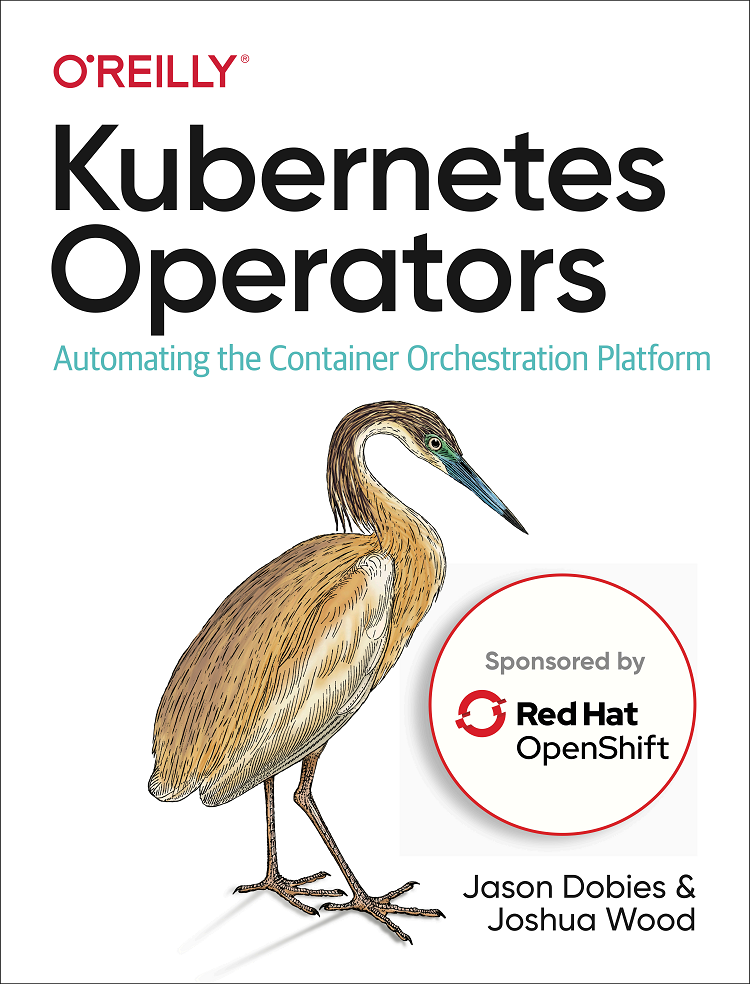《Kubernetes Operators》电子书PDF下载
《Kubernetes Operators》电子书PDF下载

Table Of Contents
-
Operators Teach Kubernetes New Tricks
How Kubernetes Works
Example: Stateless Web Server
Stateful Is Hard
Operators Are Software SREs
How Operators Work
Kubernetes CRs
How Operators Are Made
Example: The etcd Operator
The Case of the Missing Member
Who Are Operators For?
Operator Adoption
Let’s Get Going! -
Running Operators
Setting Up an Operator Lab
Cluster Version Requirements
Authorization Requirements
Standard Tools and Techniques
Suggested Cluster Configurations
Checking Your Cluster Version
Running a Simple Operator
A Common Starting Point
Fetching the etcd Operator Manifests
CRs: Custom API Endpoints
Who Am I: Defining an Operator Service Account
Deploying the etcd Operator
Declaring an etcd Cluster
Exercising etcd
Scaling the etcd Cluster
Failure and Automated Recovery
Upgrading etcd Clusters
Cleaning Up
Summary -
Operators at the Kubernetes Interface
Standard Scaling: The ReplicaSet Resource
Custom Resources
CR or ConfigMap?
Custom Controllers
Operator Scopes
Namespace Scope
Cluster-Scoped Operators
Authorization
Service Accounts
Roles
RoleBindings
ClusterRoles and ClusterRoleBindings
Summary -
The Operator Framework
Operator Framework Origins
Operator Maturity Model
Operator SDK
Installing the Operator SDK Tool
Operator Lifecycle Manager
Operator Metering
Summary -
Sample Application: Visitors Site
Application Overview
Installation with Manifests
Deploying MySQL
Backend
Frontend
Deploying the Manifests
Accessing the Visitors Site
Cleaning Up
Summary -
Adapter Operators
Helm Operator
Building the Operator
Fleshing Out the CRD
Reviewing Operator Permissions
Running the Helm Operator
Ansible Operator
Building the Operator
Fleshing Out the CRD
Reviewing Operator Permissions
Running the Ansible Operator
Testing an Operator
Summary
Resources -
Operators in Go with the Operator SDK
Initializing the Operator
Operator Scope
Custom Resource Definitions
Defining the Go Types
The CRD Manifest
Operator Permissions
Controller
The Reconcile Function
Operator Writing Tips
Retrieving the Resource
Child Resource Creation
Child Resource Deletion
Child Resource Naming
Idempotency
Operator Impact
Running an Operator Locally
Visitors Site Example
Summary
Resources -
Operator Lifecycle Manager
OLM Custom Resources
ClusterServiceVersion
CatalogSource
Subscription
InstallPlan
OperatorGroup
Installing OLM
Using OLM
Exploring the Operator
Deleting the Operator
OLM Bundle Metadata Files
Custom Resource Definitions
Cluster Service Version File
Package Manifest File
Writing a Cluster Service Version File
Generating a File Skeleton
Metadata
Owned CRDs
Required CRDs
Install Modes
Versioning and Updating
Writing a Package Manifest File
Running Locally
Prerequisites
Building the OLM Bundle
Installing the Operator Through OLM
Testing the Running Operator
Visitors Site Operator Example
Summary
Resources -
Operator Philosophy
SRE for Every Application
Toil Not, Neither Spin
Automatable: Work Your Computer Would Like
Running in Place: Work of No Enduring Value
Growing Pains: Work That Expands with the System
Operators: Kubernetes Application Reliability Engineering
Managing Application State
Golden Signals Sent to Software
Seven Habits of Highly Successful Operators
Summary -
Getting Involved
Feature Requests and Reporting Bugs
Contributing
Sharing Operators
Summary
A. Running an Operator as a Deployment Inside a Cluster
B. Custom Resource Validation
C. Role-Based Access Control (RBAC)
Index
下载地址
- 原文作者:黄忠德
- 原文链接:https://huangzhongde.cn/post/2020-02-23-kubernetes_operators_ebook/
- 版权声明:本作品采用知识共享署名-非商业性使用-禁止演绎 4.0 国际许可协议进行许可,非商业转载请注明出处(作者,原文链接),商业转载请联系作者获得授权。